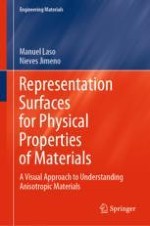This textbook presents all the mathematical and physical concepts needed to visualize and understand representation surfaces, providing readers with a reliable and intuitive understanding of the behavior and properties of anisotropic materials, and a sound grasp of the directionality of material properties. They will learn how to extract quantitative information from representation surfaces, which encode tremendous amounts of information in a very concise way, making them especially useful in understanding higher order tensorial material properties (piezoelectric moduli, elastic compliance and rigidity, etc.) and in the design of applications based on these materials. Readers will also learn from scratch concepts on crystallography, symmetry and Cartesian tensors, which are essential for understanding anisotropic materials, their design and application. The book describes how to apply representation surfaces to a diverse range of material properties, making it a valuable resource for material scientists, mechanical engineers, and solid state physicists, as well as advanced undergraduates in Materials Science, Solid State Physics, Electronics, Optics, Mechanical Engineering, Composites and Polymer Science. Moreover, the book includes a wealth of worked-out examples, problems and exercises to help further understanding.




